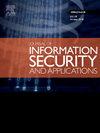Robust watermarking for diffusion models based on STDM and latent space fine-tuning
IF 3.8
2区 计算机科学
Q2 COMPUTER SCIENCE, INFORMATION SYSTEMS
Journal of Information Security and Applications
Pub Date : 2025-07-26
DOI:10.1016/j.jisa.2025.104167
引用次数: 0
Abstract
Diffusion models (DMs) have demonstrated remarkable capabilities in generating high-quality images, but their potential for disseminating harmful misinformation raises significant concerns. Although reversible watermarking techniques can trace AI-generated images to their source models by embedding watermarks in the latent space, existing methods suffer from two critical drawbacks: (i) limited embedding capacity hinders unique model identification, and (ii) information loss during latent-space re-encoding compromises robustness, exacerbating the inherent trade-off between capacity and robustness. To address these limitations, we propose a novel watermarking framework based on Spread Transform Dither Modulation (STDM) that embeds watermarks into intermediate latent vectors during the diffusion process. Our approach operates in three key steps: (i) executing the standard diffusion process to obtain an intermediate latent vector, (ii) embedding watermarks into the mid-frequency DCT coefficients of this vector using ring-shaped STDM modulation, and (iii) completing the diffusion process to generate the final watermarked image. For watermark extraction, we employ a finely tuned VAE encoder to map the image back to latent space, followed by DDIM inversion and STDM-based extraction. Furthermore, we introduce a joint fine-tuning strategy that optimizes both the encoder and decoder of the diffusion model using watermarked latent vectors, significantly enhancing robustness. Experimental results demonstrate that our method achieves a maximum watermark embedding capacity of 256 bits while maintaining a high extraction accuracy of 98%. The proposed approach exhibits remarkable robustness against various attacks, with significant improvements over baseline methods.
基于STDM和潜空间微调的扩散模型鲁棒水印
扩散模型(DMs)在生成高质量图像方面已经证明了卓越的能力,但它们传播有害错误信息的潜力引起了重大关注。虽然可逆水印技术可以通过在潜在空间中嵌入水印来跟踪人工智能生成的图像到它们的源模型,但现有方法存在两个关键缺陷:(i)有限的嵌入容量阻碍了唯一的模型识别;(ii)在潜在空间重新编码过程中的信息丢失会损害鲁棒性,加剧了容量和鲁棒性之间的固有权衡。为了解决这些限制,我们提出了一种新的基于扩展变换抖动调制(STDM)的水印框架,该框架在扩散过程中将水印嵌入到中间潜在向量中。我们的方法分为三个关键步骤:(i)执行标准扩散过程以获得中间潜在向量,(ii)使用环形STDM调制将水印嵌入到该向量的中频DCT系数中,以及(iii)完成扩散过程以生成最终的水印图像。对于水印提取,我们使用一个微调的VAE编码器将图像映射回潜在空间,然后进行DDIM反演和基于stdm的提取。此外,我们引入了一种联合微调策略,该策略使用带水印的潜在向量优化扩散模型的编码器和解码器,显著增强了鲁棒性。实验结果表明,该方法最大水印嵌入容量为256位,提取精度高达98%。所提出的方法对各种攻击具有显著的鲁棒性,与基线方法相比有显著的改进。
本文章由计算机程序翻译,如有差异,请以英文原文为准。
求助全文
约1分钟内获得全文
求助全文
来源期刊

Journal of Information Security and Applications
Computer Science-Computer Networks and Communications
CiteScore
10.90
自引率
5.40%
发文量
206
审稿时长
56 days
期刊介绍:
Journal of Information Security and Applications (JISA) focuses on the original research and practice-driven applications with relevance to information security and applications. JISA provides a common linkage between a vibrant scientific and research community and industry professionals by offering a clear view on modern problems and challenges in information security, as well as identifying promising scientific and "best-practice" solutions. JISA issues offer a balance between original research work and innovative industrial approaches by internationally renowned information security experts and researchers.
 求助内容:
求助内容: 应助结果提醒方式:
应助结果提醒方式:


